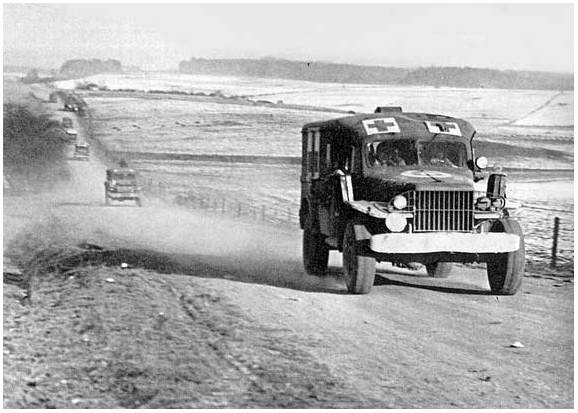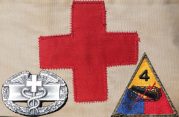It remains an epic story: the fighting around Bastogne, Belgium during the Battle of the Bulge. A besieged town, a heroic defense, and finally, the breaking of the siege.
With the breaking of the siege also came relief for the many wounded soldiers in Bastogne. By December 26th, the day that units of Reserve Command of the 4th Armored Division reached the beleaguered troops in Bastogne, most of the wounded in the town had been gathered in the barracks of Bastogne. Their situation was very serious. An immediate evacuation was of critical importance. The first convoy of ambulances would be a lifesaver. It is this first convoy that is surrounded by many questions. What unit(s) were part of this convoy? Where were the casualties evacuated to? How many casualties were evacuated? When did it reach Bastogne?
In this article, I will try to answer these questions.
The medical situation in Bastogne
Why was this first convoy so important? What was the medical situation in Bastogne?
After the 101st Airborne Division lost most of its Medical Company (326th Airborne Medical Company) on December 19th, 1944 most of the wounded were evacuated by the 429th Medical Collecting Company to the 635th Medical Clearing Company at Longlier, Belgium. These medical units operated under the control of the 64th Medical Group.
A Medical Group is a headquarters unit designed to direct all medical evacuation from second echelon (Division) units to third echelon (Army) within a designated zone, often corresponding to the operations zone of a Corps. In December 1944, the 64th Medical Group directed all evacuation for VIII Corps. These Medical Groups had several medical units attached to them: separate Medical Battalions for administrative and organizational work, Medical Clearing Companies for setting up or supporting Clearing Stations, Medical Collecting Companies, and Motor Ambulance Companies for the evacuation of wounded from divisional clearing stations.
However, the ability to evacuate the wounded out of Bastogne ended after the town became surrounded by German units on December 20th, 1944. Now the wounded in Bastogne lacked most of the second-echelon medical care and the ability to be evacuated.
This situation left the wounded in Bastogne with three major problems:
- Medical supply shortages.
- No second-echelon medical care.
- No possibility of evacuation of the wounded
- Many of the needed medical supplies were available but some became very scares such as penicillin and whole blood for transfusion. These needs were somewhat alleviated by parachute drops and the delivery of penicillin using an L-1 plane on December 25th, 1944.
- To alleviate the problem of a lack of second-echelon medical care a Third Army surgeon (Maj. Serrel) was flown into Bastogne on December 25th, 1944 by an L-1 plane. On December 26th, 1944 two Third Army surgical teams under Maj. Soutter was flown into Bastogne by glider. They were brought to the barracks in Bastogne where they started to triage the patients and began treating the patients. However, according to the AAR of the Division Surgeon of the 101st Airborne Division, the decision was made not to perform major surgical operations on the patients as there was still no possibility to evacuate them. Also because of the constant shelling and aerial attacks on Bastogne, having post-operative cases in the barracks was “not practical”. So, even with the presence of the two surgical teams, not all necessary medical care could be given.
- This all left the most crucial problem: the lack of evacuation options.
Immediately after the routes out of Bastogne were cut by the Germans, the first plans were made on where to receive the wounded out of Bastogne as soon as the siege was broken. On December 21st, 1944 The surgeon of III Corps (the forces, including the 4th Armored Division, that were fighting towards Bastogne fought under the command of III Corps) was informed that on this day some 1300 wounded men were in Bastogne, of whom around 150 were seriously wounded. A tentative plan was made by the surgeons of III Corps and VIII Corps, the CO of the 64th Medical Group, and the Division Surgeon of the 101st Airborne Division.
At this time the 10th Armored Division, which had its CCB in Bastogne, requested permission to establish a Clearing Station in Attert, Belgium to receive its wounded from Bastogne. This request was granted and the location in Attert was expanded by the addition of the 182nd Medical Battalion to create a Clearing Station capable of receiving 200 patients. On December 22nd, 1944 the 3rd platoon of the 16th Field Hospital was also sent to Attert to help with the treatment of the most seriously wounded who were received at Attert. Also, plans were made to send Ambulances from the 580th, 581st Med. Ambulance. Co. and of the 419th Med Coll. Co. to aid in the evacuation of the wounded from Attert. The AAR of the 240th Medical Battalion that had organized all the ambulances for Attert stated that this mission “never materialized and the ambulances returned to Sedan as casualties could not be brought out of Bastogne, despite efforts of armor to open cut roads”. It seems that the sit at Attert was established with the expectation that CCA of the 4th Armored Division, attacking along the N-4 highway to Bastogne, would reach the besieged troops first. When CCA was having difficulty advancing towards Bastogne due to heavy German resistance, the site at Attert was no longer to be the main evacuation site for the wounded of Bastogne.
However, on December 27th, 1944 the day after Reserve Command of the 4th Armored Division broke the siege at Assenois, the plans for the evacuation of the wounded from Bastogne were adapted to the situation. The Third Army Surgeon informed the III Corps Surgeon that evacuation would be via VIII Corps area.
I believe that this was chosen because of the location of Evacuation Hospitals ready to receive casualties.
III Corps did receive medical units that would be ready to be sent to Bastogne after the siege was broken: 495th Med. Coll. Co (which would enter Bastogne on the night of December 27th, 1944), 1st Platoon of the 60th Field Hospital (which would enter Bastogne on December 28th, 1944). Both units were sent there to treat and evacuated wounded still in Bastogne after the first convoys had evacuated most of the wounded from the barracks. This photo shows one of these medical units in Bastogne:
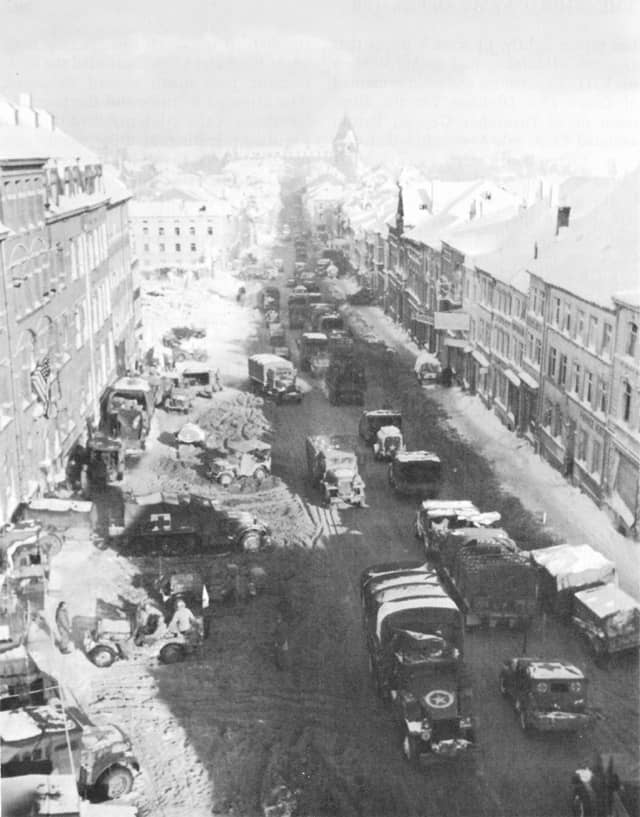
Evacuation plan for Bastogne
So, what was the final plan to evacuate the accumulated casualties at the barracks in Bastogne?
The 64th Medical Group had placed its 635th Medical Clearing Company at Villers devant Orval. Here the patients would be triaged and evacuated by other ambulances ready for evacuation to Evacuation Hospitals. (The wounded from Bastogne would be taken to the 107th Evac at Sedan, France (located at the Ecole de Textile, 1 Place du Chateau, Sedan) and the 39th Evac at Virton, Belgium (Le College St. Joseph, Rue Chanoine Crousse 1 Virton).
It also had the following units had ambulances at Villers devant Orval ready for evacuation: 581st Med Amb Co – 18 ambulances, 580th Med Amb Co – 8 ambulances, 956th Med Amb Co – 1 ambulance, 419th Med Coll Co – 5 ambulances and the 450th Med Coll Co – 6 ambulances for a total of 38 ambulances.
The AAR of the 4th Armored Division has the following on the evacuation of the wounded from Bastogne:
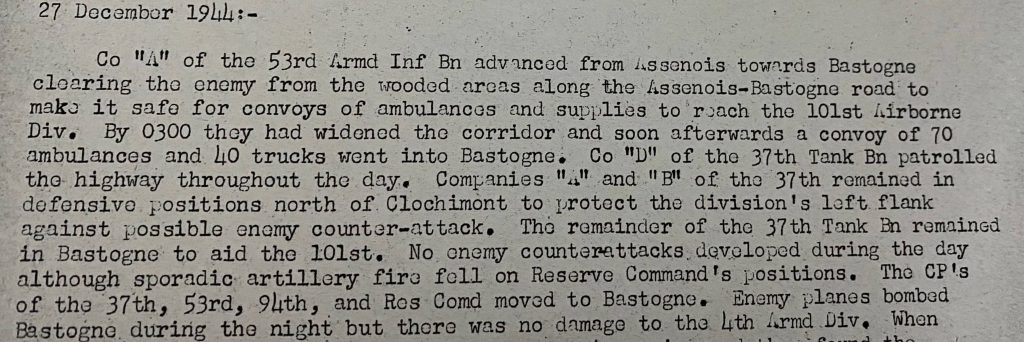
As we can see, it says that the first convoy of 70 ambulances and 40 trucks drove into Bastogne just after 0300h on December 27th, 1944.
The Unit Diary of the 53rd Armored Infantry Battalion says that the first convoy consisted of a total of 50 trucks and ambulances:
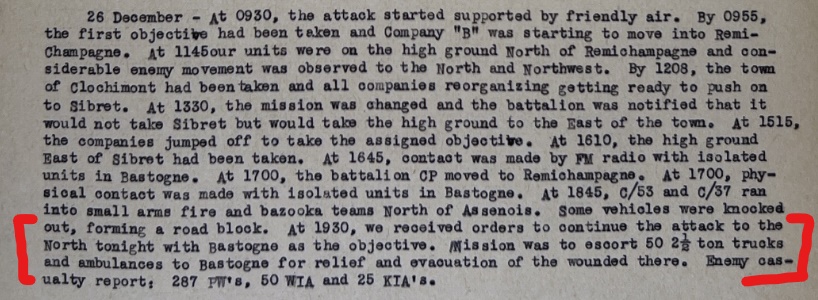
In the booklet, 4th Armored Division, from the beach to Bastogne has the following information:
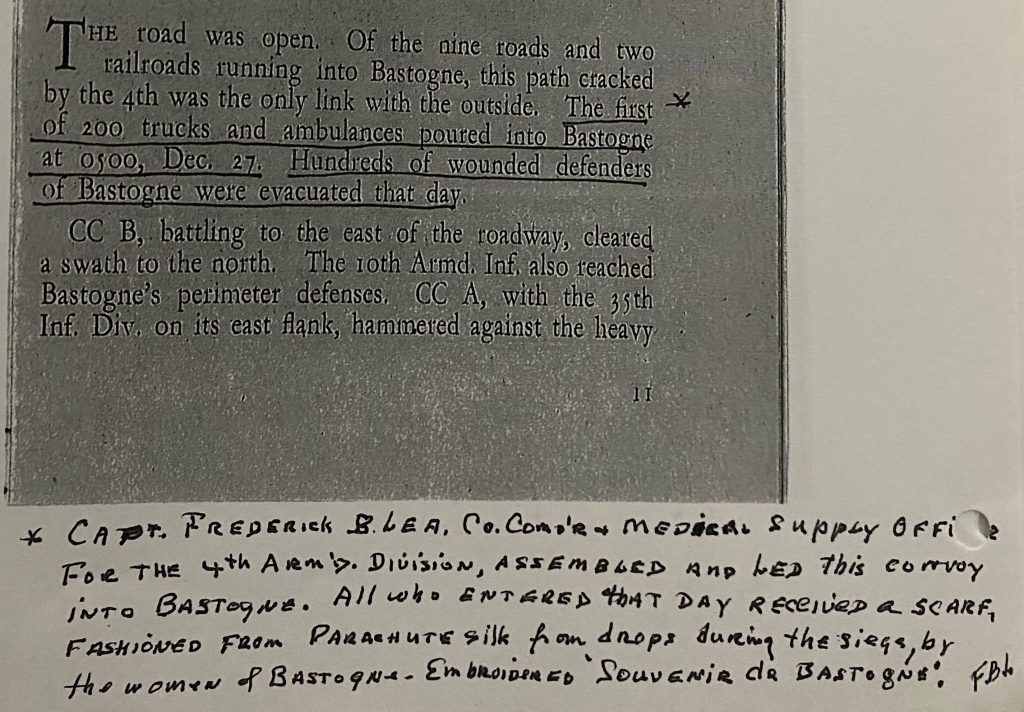
So, it states that the first convoy entered Bastogne at 0500h on December 27th, 1944 and that a total of 200 vehicles drove into Bastogne that day. Interestingly, Capt. Frederick B. Lea, Bn S-4 and commander of the HQ-company of the 46th Armored Medical Battalion noted that he helped to assemble this first convoy and escorted it into Bastogne. Also note that the men received a scarf made of parachute material.
Several other sources, including the AAR of the 64th Medical Group, the 326th Airborne Medical Company, and the 240th Medical Battalion all state that the first convoy with wounded reached Villers devant Orval in the afternoon of December 27th, 1944, and consisted of 22 ambulances with litter patients and 10 or 12 truckloads of walking wounded.
That is a big difference from the 70 ambulances and 40 trucks that the AAR of the 4th AD mentions. So, are these different convoys? Or are the sources talking about the same convoy?
The convoy arriving in Villers devant Orval returned to Bastogne, strengthened with another platoon of ambulances. This second convoy returned to Villers devant Orval at 2200h the same day. So, in two convoys of 22 plus 32 ambulances (total of 54) and 10 plus 10 trucks (total of 20) a total of around 74 vehicles evacuated wounded out of Bastogne this day. I believe that the 70 ambulances mentioned in the 4th AD AAR is actually referring to a total for the 27th of December, 1944. The other trucks mentioned were most likely supply trucks.
These two convoys evacuated a total of 652 patients out of Bastogne. The report of the Third Army Surgeon stated that the total of casualties in Bastogne was 1150 at the time. On December 28th, 1944 another 242 patients were evacuated to the 635th Medical Clearing Company. The total number of casualties evacuated out of Bastogne in the first two days after the breaking of the siege is stated as 946. Perhaps the 52 patients of this total NOT evacuated to the 635th were taken to Attert? Either way, out of a total of 1150 patients, 946 were evaluated in the first two days. That means that there was no use for an extra convoy of 70 ambulances as suggested by the 4th AD AAR.
I believe that this information gives us the chance to combine the different pieces of information into one narrative:
The first convoy of 22 ambulances and 10 or 12 trucks drove to Bastogne around 0500h on December 27th, 1944. After reaching the barracks the selection and loading of the wounded who would be evacuated first started. After this process was completed the convoy had to return to Villers devant Orval. It was dependent on armed escorts by tanks of D/37 for protection. Remember the corridor to Bastogne was extremely narrow and dangerous still.
Convoy escorted by D/37
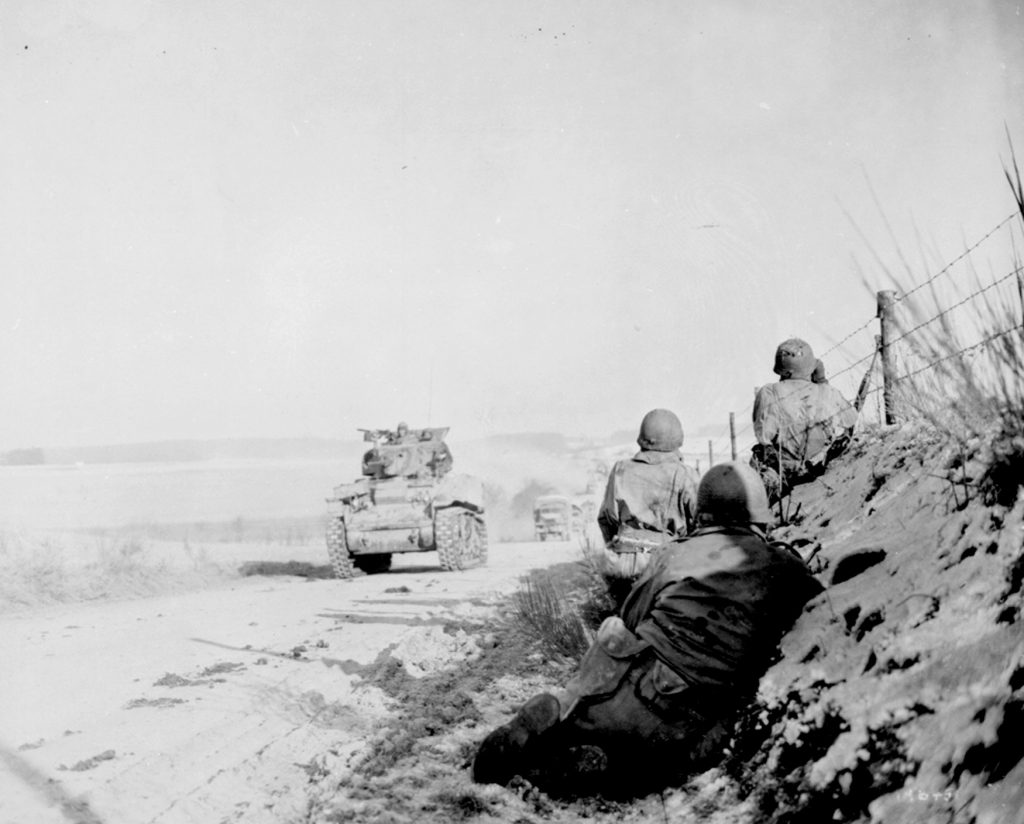
It arrived at Villers devant Orval at the beginning of the afternoon. Here the wounded were unloaded, triaged, and evacuated aboard other ambulances waiting at the 635th Medical Clearing Company.
A second convoy, this time of about 32 ambulances (one extra platoon) drove back to Bastogne in the afternoon, again under the protection of tanks of D/37, and picked up more wounded. It arrived back at the 635th Medical Clearing Company around 2200h on December 27th, 1944.
Convoy of ambulances driving to Bastogne (probably the second convoy at the end of December 27th, 1944) – This photo can be published here thanks to Erwin Verholen.
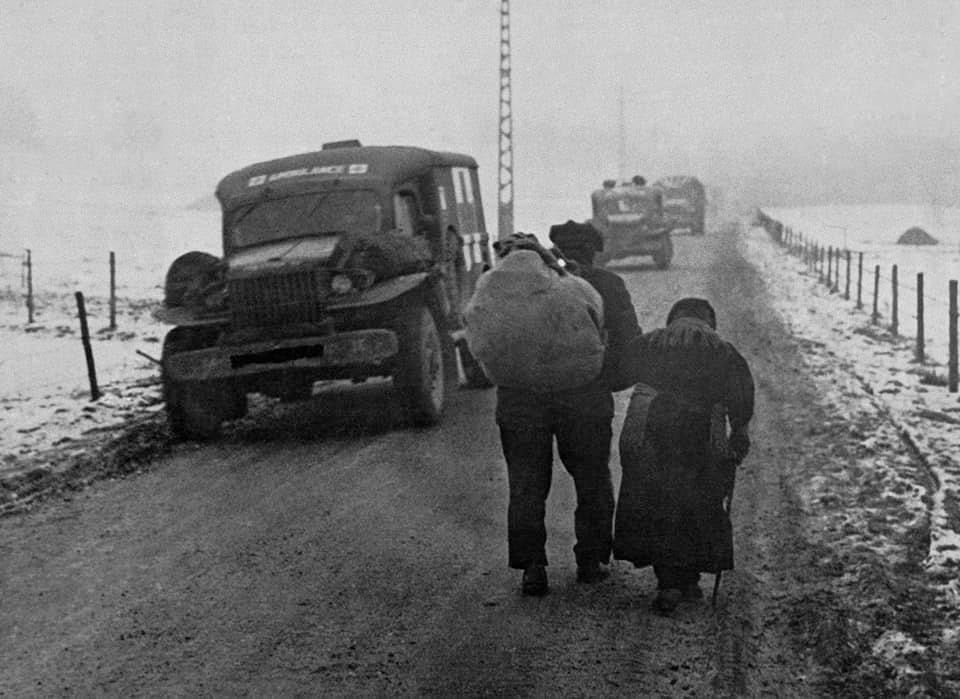
Convoy of ambulances driving out of Bastogne (probably the first convoy around noon 27th December, 1944)
